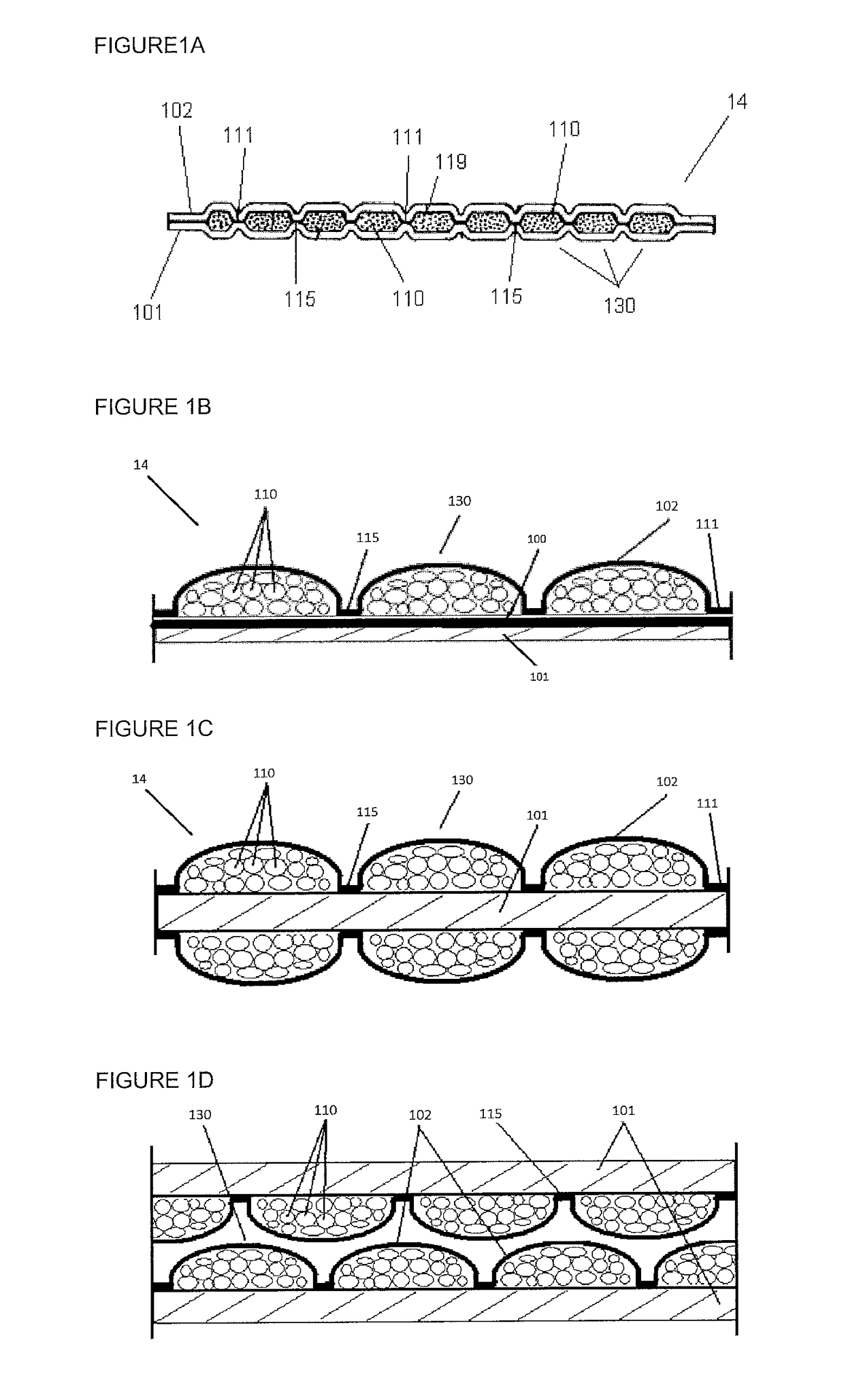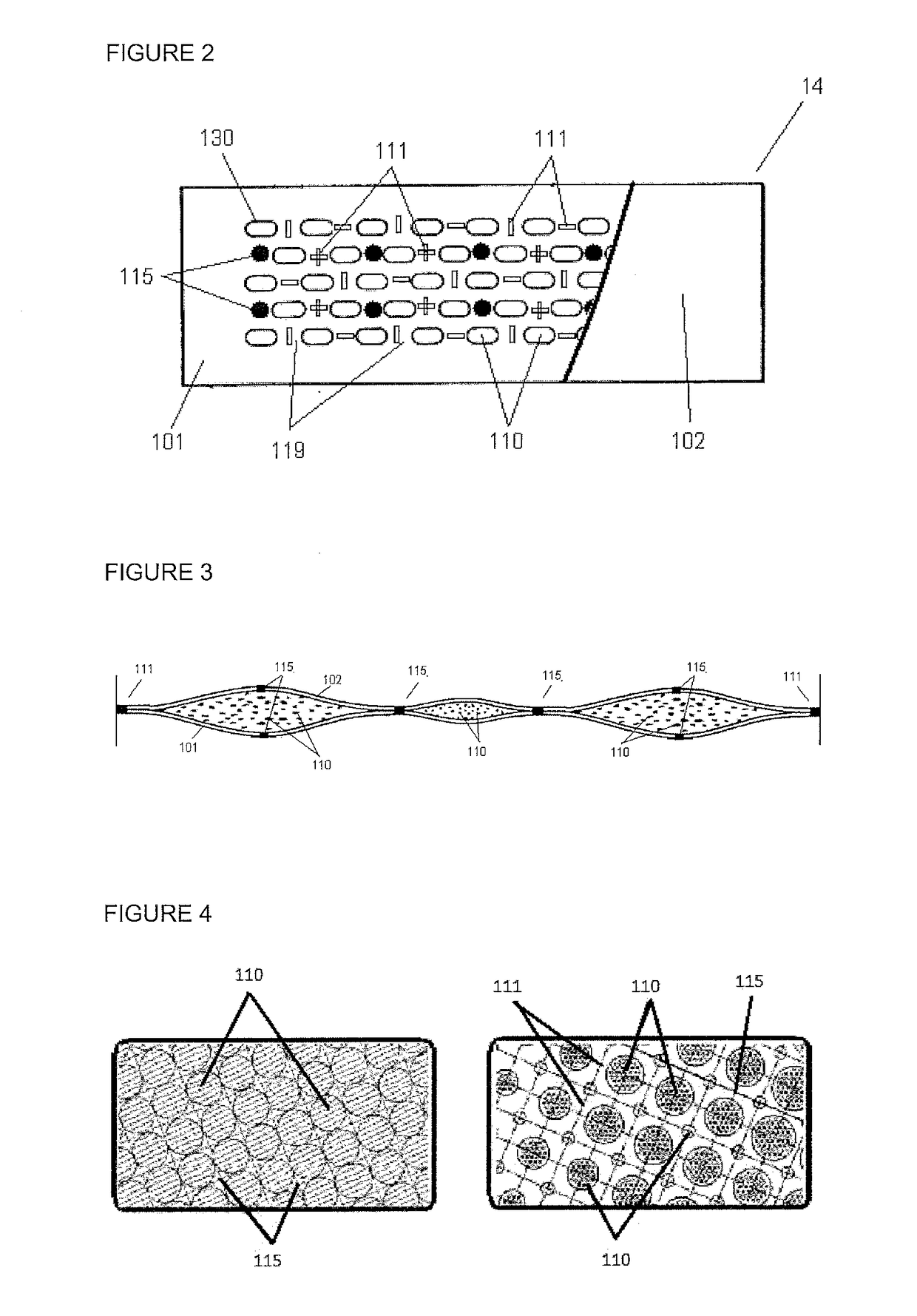These fibrous substances make these absorbent articles typically quite fluffy and bulky.
Some of these absorbent articles may be better at storing liquid, however they are not necessarily good at absorbing and distributing liquid when the absorbent article is actually being used.
Failing to provide sufficient
structural integrity results in loss of functional performance characteristics such as coherence, absorption, distribution and / or retention and results in failures related but not limited to for instance leakages, high rewet values, etc.
On the other hand however the presence of this physical and / or
chemical interaction in between the
absorbent material and the restraining material often also leads to a reduced absorption, distribution and / or retention performance.
The larger proportion of absorbent polymer materials and related immobilisation requirements in substantially
cellulose free absorbent articles may thus greatly inhibit the absorption, distribution and / or retention of liquids if inadequately managed.
Certainly decreased absorption speed and fluid distribution are common causes of failure.
Especially when absorbent polymer material concentrations are absolutely or relatively high and wetted, the hydro-gel can block the initial and / or additional fluid from reaching other still more absorbent regions of the absorbent core, thus leading to unappreciated, underused or unused absorbent capacity.
The diminished capacity results in leakages, well before the absorbent core is fully saturated.
Also the structural volume restrictions of these absorbent structures lead to a further reduced absorbent performance due to limited
swelling capacity of the absorbent polymer material increasing the tendency to functional failures and leakages.
To remedy, absorbent article designers have and typically use additional side cuffs and acquisition
layers which are expensive, inefficient and can only partly remedy these limitations.
By not completely abandoning the use of hydrophilic fibrous materials next to the use of absorbent polymer materials this problem can be partially resolved, however, it will be clear that in such case the absolute and relative proportions of absorbent materials will unwillingly be restricted and thus any thickness reduction of the absorbent structure not fully optimised.
While this construction may provide good immobilisation of the absorbent polymer material in the dry state, it seems that only a lesser immobilisation can be achieved in the liquid loaded state.
Therefore, in particular when the absorbent structure is to be used in an absorbent article to absorb and retain high amounts of bodily exudates, for example a diaper or pants, the absorbent structure disclosed herein may not be fully satisfactory.
Furthermore the fibrous bulk material increases thickness and weight, reduces flexibility and raises the cost and environmental
footprint of the absorbent structure which is highly unfavourable and undesirable.
By poor
fluid management it is meant that the regions of absorbent polymer material have insufficient integrity in dry, partially wet and / or wetted state.
This results in the physical continuity (and thus the capability of acquiring and transporting fluids through interstitial voids and capillaries) of the hydrogel formed upon swelling in the presence of fluids being substantially disrupted and altered, leading to the hydrogel
layers being unintentionally separated, having gaps being introduced, having areas that are significantly thinned and / or broken up into a plurality of underperforming segments.
Obviously this minimizing or completely negating coherence, permeability and flow
conductivity properties of the absorbent structure results in highly undesirable performance and unacceptable product failure.
However, in order to adequately secure the
absorbent material, one needs to use a significant amount of
thermoplastic material, which obviously leads to much higher costs and unappreciated stiffness and rigidity, thereby reducing good product fit, comfort and discreetness.
Furthermore the very high quantities of
thermoplastic material lead to physical and chemical shielding of the absorbent polymer materials from the fluids, leading to unavoidable reduced absorption, distribution and retention performance and importantly due to their
single use put forward a significant burden on society, industry and families from economic, environmental and
sustainability view.
Therefore, such absorbent structures are considered to be unfavourable.
Whilst the above attempts describe various approaches to various problems, it is believed that none of these absorbent structures leads to very favourable and performing absorbent structures or articles.
The inefficient use of the
absorbent material capacity and complex manufacturing processes makes neither of the above absorbent articles economically, technically and / or environmentally advantageous.
 Login to View More
Login to View More 


